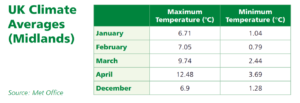A calf is born with limited body energy reserves and only a modest amount of insulation coming from hair and a low level of subcutaneous fat. In addition, lipid stores in newborn calves are extremely low; sufficient for a maximum of 15 hours of survival without feed.
The thermoneutral zone is the temperature range in which calves are able to maintain their core body temperature. In very young calves, less than 3 weeks of age, the thermoneutral zone is between 15 and 25°C. When the environmental temperature drops below 15 °C, which is referred to as the lower critical temperature, the calf must utilise energy to support vital bodily functions and to maintain its body temperature. Older calves, more than 3 weeks of age, generate more heat by rumination and they have a lower surface area to weight ratio so lose less heat. For these reasons older calves have a lower critical temperature of 10 °C.
Colostrum
Feeding calves with adequate volumes of quality colostrum during the first hours of life promotes optimum growth, reduces vet and medicine costs and increases lifetime lactation performance.
In addition to its role in passive immunity transfer and nutrient supply, colostrum feeding also helps to increase the tolerance to cold exposure. The amount of colostrum fed is positively correlated to heat production and body temperature due to the heat production represented by the energy cost associated with digestion, absorption, and metabolism of nutrients.
Following the 4 Q’s (Quality, Quantity, Quickly, and Quietly) of colostrum management can help support the best start in life.
Milk Feeding Strategy
By providing more energy to calves via the milk feed, the negative effects of cold stress can be balanced, and the calf will not be energy deficient. The best way to meet the increased energy requirements is to increase the volume of milk or milk replacer fed. Increasing the number of litres fed, or the number of feeds, will provide the extra energy needed while minimising digestive upsets. Gradually adjusting the volume of milk offered, whilst also ensuring the quality, can help to reduce the risk of scouring. Increasing concentration rates is not recommended and should be avoided
if possible, as it can increase the overall osmolality of the mixed milk which has been shown to negatively impact gut integrity and may cause nutritional scour. If volume intake is limited due to the feeding system, increase concentrations carefully. Increase feeding rates by no more than 100g over 6-8 litres/day, whilst keeping an eye on calf performance.
Do not forget to provide a fresh palatable starter feed from birth, this will encourage energy intakes. Water, an often-forgotten nutrient, is also key to promoting intakes and therefore supporting calf performance.
Calf Jackets
Another way to help mitigate the cooler weather is calf jackets. When temperatures fall below 15°C, calf jackets can be an extremely useful strategy to help keep calves warm and dry. Calves must be dry before adding a jacket as wet hair cannot insulate the calf. Jackets must be of good quality, breathable and clean. Maintaining the hygiene of jackets
is important. Washing them between calves is critically important to calf health, reducing the risk of any cross-contamination.
Bedding and Ventilation
Alongside calf jackets, increasing available bedding material for nesting, and eliminating draughts can help to maintain a desirable environment. Do not mistake drafts for ventilation, good ventilation and adequate stocking density rates are also important to successful winter housing conditions. Bedding can be effective if sufficiently deep, allowing calves to nest to reduce heat loss. Straw bedding provides the best insulation for calves. It should be at least 8cm deep, dry, and clean. If you can see the calf’s legs when it is lying down, the bedding is not deep enough and will not insulate the calf properly. Every calf rearing system is different, however having a clear cold calf protocol moving into the winter months can help support calf performance and health.
For more information and advice on maximising your youngstocks potential, get in touch with our specialists on 0800 756 2787, or click HERE.

